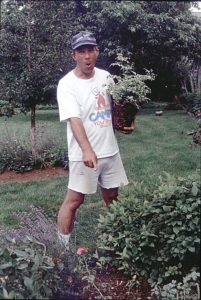Chain Reaction Time
August 16th, 2016
One of the hazards of gardening in general – and being a plant-trialing garden writer in particular – is the fact that plants always need to be moved around.

George finding an opening to cram in one more trial plant.
Some plants croak, some grow out of control, some get eaten by voles/deer/groundhogs/rabbits, and some just end up in a wrong place due to operator error or bad plant information.
This is why I make to-be-moved notes during summer so I’m ready for my next game of “musical plants.”
Plant-moving improves markedly right after Labor Day when temperatures cool and rain happens a little more often.
With list in hand, I know exactly where everything needs to go. Or at least kind of.
Apparently I’m not the only one who does this every spring and every fall.
Gardener extraordinaire and plant nut Kevin Kelly, who has at least one of every worthy plant in his nearly half-acre Lower Paxton Twp. garden, also admits to this never-ending garden editing.
He describes it as a “chain reaction” kind of thing, where, say, something dies to open up a space, which gets filled by a moved plant, which then vacates that space, which then leads to another move, and so on.
Before you know it, you’ve transplanted 14 plants to new places.
The down side of that is you’re constantly turning your garden into one with a lot of “new” plants, so far as watering goes. Any plant that moves to a new home – whether in a nursery pot from the garden center or one that you’ve dug up from the back yard – needs to be kept consistently damp for about a year until the roots recover and re-establish.
The plus side, though, is that your garden gets better and better (allegedly) as you learn the little intricacies of each microclimate and improve on your pairings.
A big benefit of gaining experience in your own yard is that you should kill or maim fewer and fewer plants over time. As you figure out where it’s slightly warmer or slightly wetter or surprisingly windy in winter, you’ll get better at matching the exact plants that are best suited for each site.
In the beginning, all you can do is make your best guess. Many people don’t even pay enough attention to do that – just sticking whatever catches their eye wherever they feel like it without regard to plant needs.
No wonder success rates are needlessly low for people who are winging it. But pay attention over time, and you get to be a master at knowing what’s probably going to work.
That’s when you “magically” develop a green thumb.
The way I look at it, every bad guess I make and every plant I kill or abuse is a lesson learned for the next time.
As time goes along, I should be transplanting less and guessing right more often on the first try.
Good thing I keep getting new trial plants to try. That forces me to make moves so I can serve as a local guinea pig, freeing you all from doing trial-and-error.
I find that moving plants around is a creative thing to do, which to me, is the most fun part about gardening. It’s certainly not mulching or chasing groundhogs around.
It wouldn’t be any fun at all if my garden was ever really “done.”







